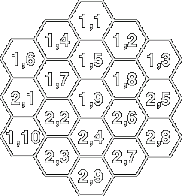OtherDuel: Basic Rules
OtherDuel is a suprarealistic game of ship construction and destruction between mutually opposing sides. Two or more players, free-for-all or teams, last side "standing" wins (more on what that means later).
Antagonists
Each "ship" is called an Antagonist. Antagonists are represented as a series of (mostly) connected hexes known as Modules. Antagonists come in Levels, where each Level is composed of ten Modules. Modules are semi-independent units of limited Volume (V). Each Module has 10 Volumes available for populating with 'Wares, which are the actual "worky bitz" of the Antagonists. (See Basic 'Wares for specifics, and the optional rule Command Module for an exception to the 10 Volumes). A given Module is referred to by it's Coordinate, such as (2,8) which is Module 8 (out of 10) of Level 2 (out of however many Levels the Anatagonist has). However, the actual layout of the Antagonist on the two-dimensional hex grid is completely separate from the Coordinate System, and the idea of Levels breaks down as well. Any number of Modules from any series of Levels may comprise the two-dimensional shape of the Antagonist on the board. Additionally, not all Modules are required to be represented on the board. They are part of the Antagonist, but not "in play" on the board. However, they can be used for storing "ammo", and can be switched with Modules that are in play (more on that much later).
Example: Module Layout
Consider the two-level Antagonist pictured here. The Antagonist is composed of 20 Modules, 10 on Level 1, and 10 on Level 2. By design, 19 of the Modules are placed on the board in a tightly packed formation, and one Module (2,10) is not placed on the board.

Note that the location of the Modules with respect to Level and Coordinate needs no particular order on the board. The Antagonist's Record Sheets take care of keeping track of all of that. In practice, labeling them with letters (A, B, C) is common, and recording those letters on the Record Sheets on the appropriate Module.
The one off-board Module (2,10) may still contain 'Wares, but no commands can be issued to it or from it. If it contains OffWares, they cannot "fire", having no location on the board to fire from; if it contains ComWares, it cannot issue commands, becasue no path can be traced from it to any other 'Wares. However, "ammo" can be stored in that off-board Module, which can be used for OffWares on the board; no path need be traced from a Limited OffWare (the "ammo") to it's OffWare Accessory (the "gun").
As implied by the above example, all modules placed in the Antagonist must be connected somehow. While perhaps impractical, it would also have been perfectly legal to leave a hole in the middle of the Antagonist, or string out all the Modules in a long line.
There is a way to spread out the Modules without "wasting" Modules just for the sake of reach. For each level of the Antagonist, 10 Chain hexes are available. Chain hexes are not Modules; they have no representation on the Record Sheet, and can contain no 'Wares. However, they can be used to connect Modules together. All Antagonists, when designed, must be a contiguous series of connected Modules and/or Chain. Chain spaces are "empty" for all considerations of OffWares; they cannot be targeted, do not block line of fire, and Deadfire OffWares pass right through them.
Example: Chain hexes
Consider the Antagonist of the previous example. Since this Antagonist has 2 Levels, it may have up to 20 Chain hexes. Rather than having the 20th Module off-board, it could instead have been designed to have the Module well-separated from the main bulk, but attached with Chain hexes. It could be a long line, 20 Chain hexes long, or a "bundle" of chain 3 hex-rows wide, as seen in the figure. (Why would you do that? Because it makes it more difficult to Clip.)

